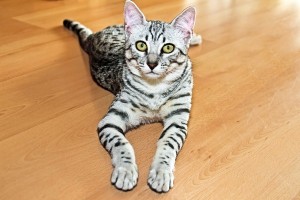 The Egyptian Mau is an African wild cat that is thought to be the cat originally domesticated by the Egyptians over 4,000 years ago. Cats depicted in ancient Egyptian artwork resemble the spotted Egyptian Mau and show that they were used for duck hunting as well as being worshipped by a cat cult. Feline genome data actually shows that the Egyptian Mau is more closely related to Western-derived breeds than those of the eastern Mediterranean. However, the Egyptian Mau has some distinct characteristics not seen in other breeds. Its ancient lineage notwithstanding, the Egyptian Mau was first shown in Europe prior to World War I, but during the war, its numbers were decimated with most of its known survivors found in Italy. Russian Princess Nathalie Troubetskoy, exiled in Rome shortly before World War II,was given a spotted Egyptian Mau kitten she named Baba. In 1956, Princess Troubetskoy emigrated to the US, bringing with her Baba and two other rescued Mau. Shortly thereafter, she established her cattery and established Egyptian Maus as a recognized breed in North America. Egyptian Maus were recognized by the Cat Fanciers’ Association in 1968 and The Canadian Cat Association shortly after.
The Egyptian Mau is an African wild cat that is thought to be the cat originally domesticated by the Egyptians over 4,000 years ago. Cats depicted in ancient Egyptian artwork resemble the spotted Egyptian Mau and show that they were used for duck hunting as well as being worshipped by a cat cult. Feline genome data actually shows that the Egyptian Mau is more closely related to Western-derived breeds than those of the eastern Mediterranean. However, the Egyptian Mau has some distinct characteristics not seen in other breeds. Its ancient lineage notwithstanding, the Egyptian Mau was first shown in Europe prior to World War I, but during the war, its numbers were decimated with most of its known survivors found in Italy. Russian Princess Nathalie Troubetskoy, exiled in Rome shortly before World War II,was given a spotted Egyptian Mau kitten she named Baba. In 1956, Princess Troubetskoy emigrated to the US, bringing with her Baba and two other rescued Mau. Shortly thereafter, she established her cattery and established Egyptian Maus as a recognized breed in North America. Egyptian Maus were recognized by the Cat Fanciers’ Association in 1968 and The Canadian Cat Association shortly after.
In 1972, a silver Egyptian Mau female bred by Princess Troubetskoy became the first Egyptian Mau to win a Canadian Cat Association grand championship.
The Mau is a medium-size cat of 6 to 14 pounds, its most striking characteristic is his spotted coat in silver, bronze, or smoke (pale silver fur tipped in black), closely followed by his large gooseberry-green eyes. He is a medium-sized cat with a muscular body and a slightly rounded wedge-shaped head topped with medium-size to large ears. With hind legs slightly longer than the front legs, he gives the appearance of standing on tiptoe on his small, dainty feet . A medium-long tail is thick at the base, tapering slightly at the end.
Maus likes to sit up high and survey their surroundings. They usually act as if they are in complete control of their environment. They are extremely strong and very active. But they have a very balanced temperament.
We know that because you care so much about your cat, you want to take great care of him. That is why we have summarized the health concerns we will be discussing with you over the life of your Mau. By knowing about the health concerns common among Egyptian Maus, we can help you tailor an individual preventive health plan and hopefully prevent some predictable risks in your pet.
Heart Disease: Cardiomyopathy is the medical term for heart muscle disease, either a primary inherited condition or secondary to other diseases that damage the heart. The most common form called hypertrophic cardiomyopathy, or HCM, is a thickening of the heart muscle often caused by an overactive thyroid gland.
Renal failure: refers to the inability of the kidneys to properly perform their functions of cleansing waste from the blood and regulating hydration. Kidney disease is extremely common in older cats but is usually due to exposure to toxins or genetic causes in young cats.
Allergy/Atopy : In humans, an allergy to pollen, mold, or dust makes people sneeze and their eyes itch. In cats, it makes the skin itchy. We call this form of allergy “atopy.” Commonly, the legs, belly, face, and ears are very likely to have this problem.
Sources: https://lefthandanimalhospital.com/client-resources/breed-info/egyptian-mau/

